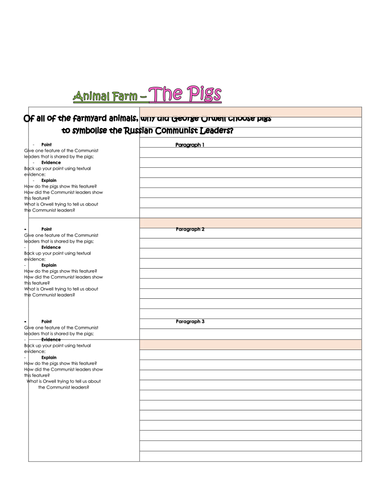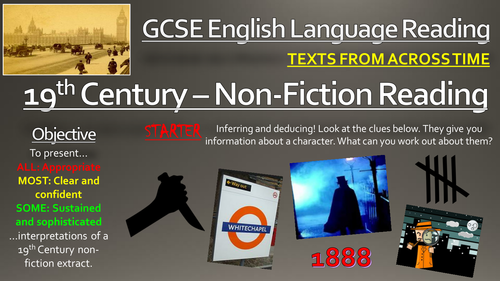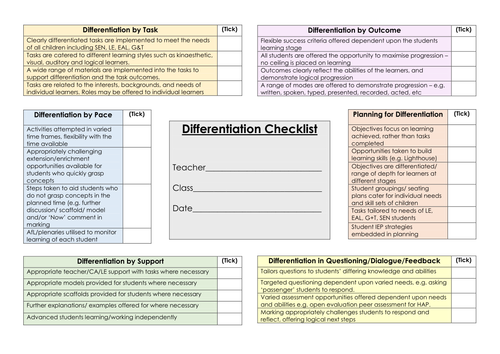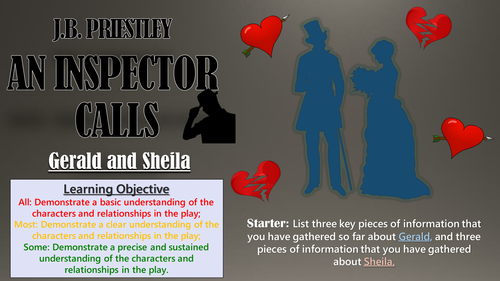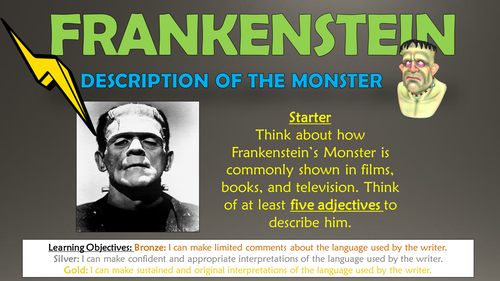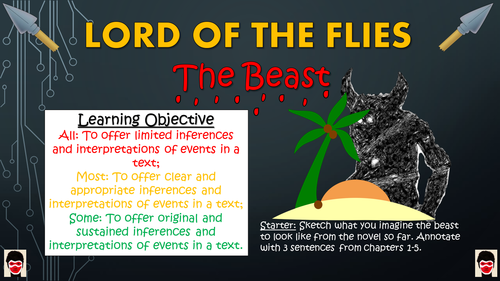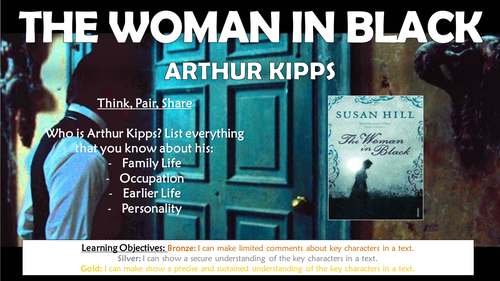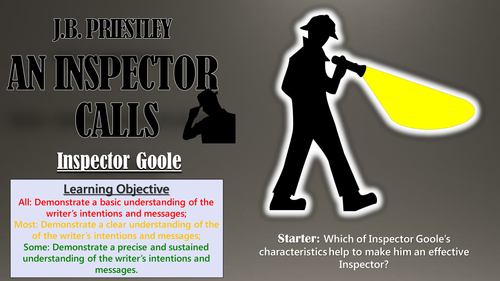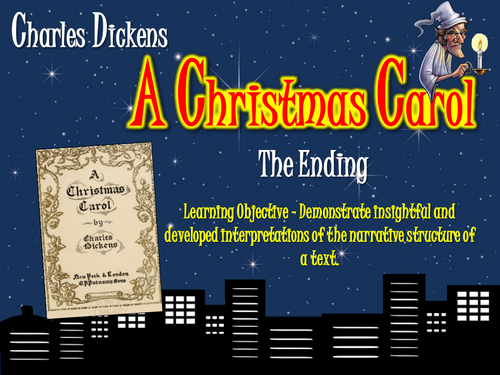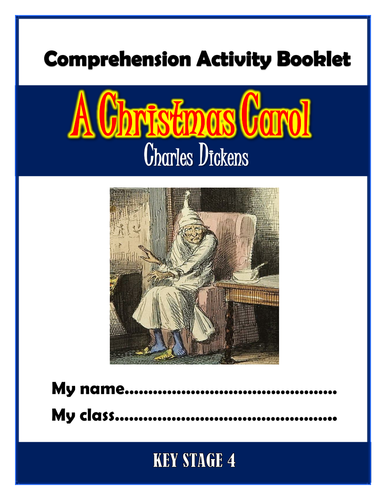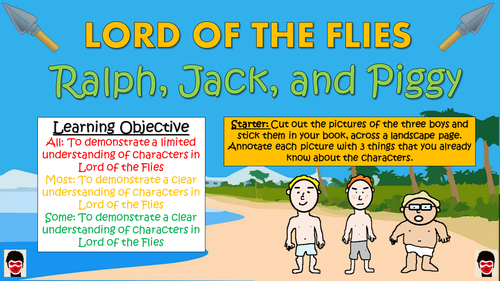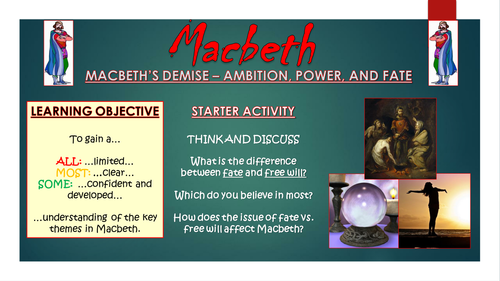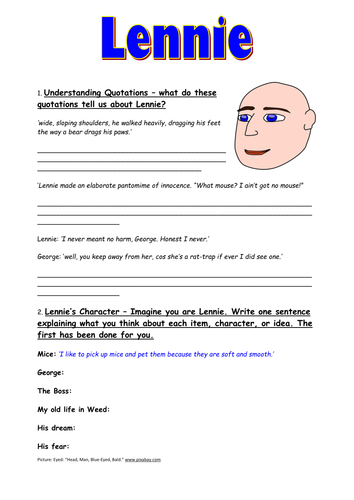
3k+Uploads
1884k+Views
2223k+Downloads
New teachers

An Inspector Calls: Arthur Birling
This interesting and engaging lesson enables students to build their understanding Arthur Birling, one of the chief protagonists in J.B. Priestley’s ‘An Inspector Calls.’ In particular, students learn about his characteristics, his attitudes and opinions towards the world around him and other people, and also his relevance to Priestley’s social and historical context.
The lesson follows a clear, logical, bite-size learning journey, which guides students towards differentiated learning objectives. Over the course of this journey, they become able to:
- Recall and understand the key features of Birling's character profile;
- Link Birling to the social and historical context of the play;
- Understand how Birling's character is significant in terms of Priestley's key message;
- Read and understand the section of the play in which Birling is interviewed by the inspector;
- Analyse key quotations by and about Birling in the text;
- Read and understand the opening of the play;
- Create a diary-entry piece in which they consider Birling's morals and sense of responsibility for the death of Eva Smith;
-Peer/self-assess learning attempts.
This resource pack includes:
- A visually engaging whole-lesson PowerPoint presentation;
- Images of Birling to be annotated for the starter task;
- A clear and interesting worksheet for the introductory task;
- An extract from Act 1 of the play for students to read and interpret;
- P.E.E template for students to complete their character analysis;
- A detailed lesson plan, complete with what the teacher and students should aim to achieve at each stage of the lesson.
All images are licensed for commercial use, and are cited on the final slide of the PowerPoint.

Animal Farm: The Rise of the Pigs!
These resources enable students to understand and analyse the rise of the pigs towards power in chapters 3 and 4 of George Orwell’s Animal Farm. More precisely, students learn to make clear and accurate interpretations about the emergence of the various characters as leaders on the farm, with appropriate links to individual characters and their allegorical relationship to context.
Students learn through the following tasks:
- Gauging and collaborating prior knowledge through a discussion-based starter task;
- Reading chapters 3 and 4 and demonstrating their understanding through a related group quiz activity;
- Developing their understanding of the changing nature of characters, and their allegorical ties, through a quotation retrieval mind mapping task;
- Analysing the allegorical nature of the pigs, by further exploring their characteristics in relation to those of the communist Russian leaders of the early 20th century;
- Peer assessing their partners' learning attempts.
The following resources are provided:
- Engaging and colourful step-by-step PowerPoint
- Teacher lesson guidance/plan;
- Analytical paragraphs worksheet;
- Mind-mapping activity template;
- Copies of Chapters 3 and 4.
All images are licensed for commercial use, and are cited on the final slide of the PowerPoint.

New GCSE English Language Reading: 19th Century Non-Fiction
These informative and engaging resources enable students to build the skills needed to interpret and analyse 19th Century non-fiction texts. This will aid students through the new Paper 2 Section A of GCSE English Language - for which they need to become confident readers of 19th, 20th, and 21st Century non-fiction texts. These resources give students a strong foundation of knowledge of features of non-fiction texts in the 19th Century, using newspaper stories from the time based on 'Jack the Ripper' as the predominant examples. There are easily enough resources for at least two lessons within this resource pack.
Students learn through the following tasks:
- Inferring and deducing contextual knowledge through an interactive starter task;
- Understanding the features of London in 1888 through a video introduction;
- Building close reading skills through a study of a non-fiction extract about Jack the Ripper;
- Answering exam-style questions interpreting and inferring the key meanings in the text;
- Using models and templates to write extended analysis responses about the language used in the non-fiction extract;
- Peer assessing their partners' learning attempts.
The following resources are provided:
- Engaging and colourful step-by-step PowerPoint;
- Jack the Ripper newspaper extract;
- Teacher lesson guidance;
- Interpretation worksheet;
- Analysis worksheet;
- Writing to analyse.
All images are licensed for commercial use, and are cited on the final slide of the PowerPoint.

Learning Walk/ Teacher Development Checklists
These comprehensive checklists have been created to aid school leaders when performing learning walks with a particular focus e.g. questioning, differentiation, etc. Clearly structured and organised, they present a central idea surrounded by a breakdown of a number of its key components.
For the user, this layout provides a simple reference list of each of the desirable skills, categorised appropriately. The checklists also provide an alternative to regular feedback methods, which often focus too heavily on the standard or ‘judgement’, as opposed to being a developmental tool.
Alternatively, these are really handy for teachers looking to develop their practice in the key teaching areas listed below. Included in the pack are checklists for:
-Questioning
-Differentiation
-Utilising Resources (including support staff)
-Engagement
-Building Literacy Skills
-Planning and Expectations
-Building Learning Power
-A blank template for you to design your own based upon your own focus
Note: The checklists offer a range of desirable strategies that teachers should look to implement over time - it would be damaging to expect teachers to utilise each of these strategies in every lesson!
Many Thanks

An Inspector Calls: Gerald and Sheila
This interesting and engaging lesson enables students to build their understanding of the relationship between Gerald and Sheila, two of the main characters in ‘An Inspector Calls.’ In particular, students learn about about how both characters contribute to the downfall of Eva Smith, and how their relationship is affected as details of their actions emerge.
The lesson follows a clear, logical, bite-size learning journey, which guides students towards differentiated learning objectives. Over the course of this journey, they become able to:
- Recall and understand the key features of Gerald and Sheila's character profiles;
- Link Gerald and Sheila to the historical context of the play;
- Read and understand the section of the play in which Gerald is interviewed by the inspector;
- Analyse the effect of Gerald's revelations on the relationship of Gerald and Sheila;
- Create a diary-entry piece in which they consider Gerald's character and relationships with both Sheila and Daisy Renton;
-Peer/self-assess learning attempts.
This resource pack includes:
- A visually engaging whole-lesson PowerPoint presentation;
- A clear and interesting worksheet for the development task (with answer sheet);
- An extract from Act 2 of the play for students to read and interpret;
- Guidance for completing diary entries;
- A detailed lesson plan, complete with what the teacher and students should aim to achieve at each stage of the lesson.
All images are licensed for commercial use, and are cited on the final slide of the PowerPoint.

Frankenstein: Shelley's Description of the Monster!
This lesson aims to improve students’ understanding of the descriptive language used to depict the monster in Chapter 5 of Mary Shelley’s horror novel 'Frankenstein.' The lesson places a particular focus upon the descriptive language devices employed by Shelley, in order to create a clear image of the monster’s appearance in the reader's mind, and also to describe Victor’s strong reaction to his creation. By the end of the lesson, students demonstrate an ability to make sustained and original interpretations of the language used by the author.
The lesson follows a step-by-step learning journey, in which children learn through:
- Considering how their preconceptions about the monster have been influenced by modern media and representations;
- Read and understand a key extract from the beginning of chapter 5 - the point at which the monster comes to life;
- Infer and interpret the key developments of the extract, including Frankenstein's changing feelings and the monster's ambiguous actions;
- Identifying and analysing some of the key descriptive devices used by Shelley to create an image of the monster;
- Analysing the effect of the descriptive devices upon the reader;
- Peer assessing each other's learning attempts.
Included is:
- Whole lesson PowerPoint - colourful and substantial; (including an animated Frankenstein's monster to guide them through the lesson);
- Descriptive devices worksheet (and a teacher answer sheet);
- Extract from the beginning of Chapter 5;
- Inferring and Interpreting worksheet;
- Analysis template with success criteria for creating well-structured responses;
- Comprehensive lesson plan.
There are also opportunities for group learning, peer assessment, and whole class discussion. This was originally taught to middle-ability year 9/10 groups, but can easily be differentiated for groups of different ages and abilities.
All images are licensed for commercial use, and image rights are listed on the last page of the presentation.

Lord of the Flies: Golding's Language Devices
This interesting and highly-stimulating lesson enables students to gain a clear understanding of the language choices utilised by William Golding’s throughout Chapters 4 and 5 of Lord of the Flies, with particular reference to the advanced figurative language employed in the descriptive sections of the text. Students also learn to analyse the effects of key language choices, with reference to Golding's key intentions throughout the novel.
The lesson follows a clear, logical, bite-size learning journey, which guides students towards differentiated learning objectives. Over the course of this journey, they become able to:
- Define, identify, and exemplify different types of language devices;
- Explain the effects of different language devices on meanings and different audiences;
- Read and understand Chapters Four and Five of the play, with a particular focus upon how Golding utilises language devices to demonstrate the changing feelings and mindsets of the boys on the island;
- Analyse key quotations which utilise effective descriptive devices;
- Analyse the effectiveness of Golding's language devices;
-Peer assess each other's learning attempts.
This resource pack includes:
- A visually engaging whole-lesson PowerPoint presentation;
- Detailed worksheets, with answer sheets where necessary;
- Links to the extracts of the text needed for the lesson (Chapters Four and Five in this case);
- Card sort cards;
- A detailed lesson plan, complete with what the teacher and students should aim to achieve at each stage of the lesson.
All images are licensed for commercial use, and are cited on the final slide of the PowerPoint.

An Inspector Calls: The Context of the Play
These interesting and engaging resources enable students to build their understanding of the context of J.B. Priestley’s play ‘An Inspector Calls.’ In particular, students learn how to make clear and appropriate links between the social and historical context and the play itself. This gives students a really stable knowledge-base from which to make inferences and interpretations about other parts of the play.
The lesson follows a clear, logical, bite-size learning journey, which guides students towards differentiated learning objectives. Over the course of this journey, they become able to:
- Recall the main events that occurred between 1912 and 1945, through an interactive group activity;
- Remember some key information about J.B Priestley and his beliefs;
- Read and understand the opening of the play;
- Make links between the opening of the play and the historical context - both in term of when the play was set, and when it was written;
- Analyse how Priestley links historical context to his characters, in order to get his messages across to the audience;
-Peer/self-assess learning attempts.
This resource pack includes:
- A visually engaging whole-lesson PowerPoint presentation;
- A clear and interesting worksheet for the development task;
- The opening of the text for students to read and interpret;
- Context information cards for the card-sorting game;
- A detailed lesson plan, complete with what the teacher and students should aim to achieve at each stage of the lesson.
All images are licensed for commercial use, and are cited on the final slide of the PowerPoint.

Lord of the Flies: The Beast
This interesting and highly-stimulating lesson enables students to make important inferences and interpretations regarding ‘the beast’ that is referred to by the boys on the island throughout William Golding’s novel Lord of the Flies. In particular, students form opinions of what the beast may represent, based upon key evidence throughout the text.
The lesson follows a clear, logical, bite-size learning journey, which guides students towards differentiated learning objectives. Over the course of this journey, they become able to:
- Establish, sketch, evidence, and share their initial interpretations of the beast;
- Collaborate with others to form rational and substantiated opinions;
- Read and understand Chapters Six and Seven of the play, with a particular focus upon how Golding utilises the beast to depict other concepts and notions;
- Analyse key quotations which refer to the beast in relation to each of the characters;
- Give appropriate and sustained interpretations and inferences regarding altering views towards Golding's use of the beast;
-Peer assess each other's learning attempts.
This resource pack includes:
- A visually engaging whole-lesson PowerPoint presentation;
- Detailed worksheet;
- A scaffolded essay template;
- Links to the extracts of the text needed for the lesson (Chapters Six and Seven in this case);
- A detailed lesson plan, complete with what the teacher and students should aim to achieve at each stage of the lesson.
All images are licensed for commercial use, and are cited on the final slide of the PowerPoint.

A Christmas Carol: The Development of Scrooge!
This engaging and informative lesson enables students to make insightful and developed interpretations regarding the character of Ebenezer Scrooge in ‘A Christmas Carol.’ In particular, they explore how his character is originally introduced, and then developed throughout the appearances of the three ghosts.
The lesson follows a step-by-step learning journey, in which children learn through:
- Reading and understanding the selected extracts to determine the key traits of Scrooge's character at different points in the text;
- Noticing trends in Scrooge's character throughout the text, observing how he has developed from the opening of the text through completion of a 'Character Arc.'
- Analysing Dickens' intentions in developing the character of Scrooge throughout the text;
- Peer assessing each other's learning attempts.
Included is:
- Whole lesson PowerPoint - colourful and comprehensive;
- Selected extracts demonstrating Scrooge's development;
- Character Arc template;
- Analysis template with success criteria for creating well-structured responses;
- Comprehensive lesson plan.
There are also opportunities for group learning, peer assessment, and whole class discussion. This was originally taught to mixed ability year 10 groups, but can easily be differentiated for groups of different ages and abilities.
All images are licensed for commercial use, and image rights are listed on the last page of the presentation.

Frankenstein: The Portrayal of Women!
This engaging and informative lesson aims to improve students’ understanding of the portrayal of women in Mary Shelley’s Frankenstein. The lesson places a particular focus upon the perceived role and characteristics of women in the late 1700s, and compares this to the manner in which they are presented in the text. By the end of the lesson, students demonstrate an ability to argue whether they think Shelley’s portrayal of women challenges or recycles existing ideas of women living at the time.
The lesson follows a step-by-step learning journey, in which children learn through:
- Understanding the social and historical context of life for women in the late 1700s;'
- Making links between contextual understanding and what is noted from the text;
- Reading and understanding key extracts from chapters 8, 22, and 23 - extracts that provide exposure to the female characters in the text;
- Inferring, and interpreting the key events of the extracts, and considering the impression that is given of women by Shelley;
- Arguing whether they feel that Shelley recycles or challenges the role of women at the time, using a purpose-made essay template;
- Peer assessing each other's learning attempts.
Included is:
- Whole lesson PowerPoint - colourful and substantial; (including an animated Frankenstein's monster to guide them through the lesson);
- Inferring and interpreting worksheet (and a teacher answer sheet);
- Extracts from Chapters 8, 22, and 23;
- The role of women worksheet;
- Analysis template with success criteria for creating well-structured responses;
- Comprehensive lesson plan.
There are also opportunities for group learning, peer assessment, and whole class discussion. This was originally taught to middle-ability year 9/10 groups, but can easily be differentiated for groups of different ages and abilities.
All images are licensed for commercial use, and image rights are listed on the last page of the presentation.

The Woman in Black: Arthur Kipps!
This engaging and informative lesson enables students to make precise and sustained interpretations regarding the portrayal of Arthur Kipps throughout Susan Hill’s The Woman in Black. In particular, students consider how Kipps is initially presented, and how his character is developed throughout the text.
The lesson follows a step-by-step learning journey, in which children learn through:
- Reading and understanding how Arthur's character is introduced to the reader;
- Understanding and comprehending the different events that Arthur experiences;
- Considering how these different events shape and alter Arthur's emotions and personality;
- Analysing how Hill presents and develops Arthur's character throughout the text;
- Peer assessing each other's learning attempts.
Included is:
- Whole lesson PowerPoint - colourful and comprehensive;
- Selected extracts from 'The Woman in Black'
- Arthur Kipps stress graph;
- Analysis template with success criteria for creating well-structured responses;
- Comprehensive lesson plan.
There are also opportunities for group learning, peer assessment, and whole class discussion. This was originally taught to mixed ability year 10 groups, but can easily be differentiated for groups of different ages and abilities.
All images are licensed for commercial use, and image rights are listed on the last page of the presentation.

An Inspector Calls: Inspector Goole
This interesting and engaging lesson enables students to build their understanding of Inspector Goole, one of the chief protagonists in ‘An Inspector Calls.’ In particular, students understand the Inspector’s main characteristics and quotations. They also contemplate whether they feel the Inspector presents the voice and key messages of Priestley himself.
The lesson follows a clear, logical, bite-size learning journey, which guides students towards differentiated learning objectives. Over the course of this journey, they become able to:
- Recall and understand the key features of The Inspector's character profile;
- Link The Inspector to Priestley's key messages and the context of the play;
- Piece together the Eva Smith case from the viewpoint of The Inspector;
- Read and understand the final section of the play;
- Analyse the character further in response to key quotations;
- Argue the extent to which the Inspector presents the views of Priestley himself;
- Peer/self-assess learning attempts.
This resource pack includes:
- A visually engaging whole-lesson PowerPoint presentation;
- A clear and interesting worksheet on interpreting The Inspector's character;
- Extract from Act 3 of the play for students to read and interpret;
- Inspector's notepad to piece together the Eva Smith case;
- A scaffolded template for students to complete the main analysis task;
- A detailed lesson plan, complete with what the teacher and students should aim to achieve at each stage of the lesson.
All images are licensed for commercial use, and are cited on the final slide of the PowerPoint.

A Christmas Carol: The Ending!
This engaging and informative lesson enables students to make insightful and developed interpretations regarding the ending of Dickens’ ‘A Christmas Carol.’ In particular, they explore how the ending is in keeping with the traditional features of resolutions stage in the narrative structure model.
The lesson follows a step-by-step learning journey, in which children learn through:
- Clarifying the events leading up to the end of the novel;
- Reading and comprehending the events of Stave 5 - the end of the novel;
- Understanding the key stages of Narrative Structure and applying 'A Christmas Carol' to this model;
- Analysing Dickens' ending in relation to the key features of traditional resolutions;
- Peer assessing each other's learning attempts.
Included is:
- Whole lesson PowerPoint - colourful and comprehensive;
- Extract - Stave 5
- Narrative Structure Template;
- Analysis template with success criteria for creating well-structured responses;
- Comprehensive lesson plan.
There are also opportunities for group learning, peer assessment, and whole class discussion. This was originally taught to mixed ability year 10 groups, but can easily be differentiated for groups of different ages and abilities.
All images are licensed for commercial use, and image rights are listed on the last page of the presentation.

Writing Newspaper Articles!
This interesting and engaging enables students to know what newspaper articles are and why people read them, understand the features that make effective newspaper articles, and write their own interesting and appropriate newspaper articles. In particular, students learn to use a range of appropriate features in writing their own newspaper articles, including facts and opinions, jargon, testimonies, and puns. There are easily enough resources here for 2 lessons on this topic.
Over the course of their learning journey, students:
- Define and exemplify what newspapers are;
- Understand why people read newspapers;
- Understand and categorise the different techniques used by newspapers;
- Identify the features of newspapers in model examples;
- Analyse the effect of techniques in newspapers upon the reader;
- Use a wide-range of techniques in writing their own newspaper articles;
- Peer and self assess each other's newspaper article attempts.
The resources include:
-Visually engaging whole-lesson PowerPoint;
-A colourful and helpful 'Writing Newspaper Articles' Help-Sheet;
-Techniques cards for defining the key key features of newspaper articles;
-Analysing newspaper articles worksheet;
-Blank newspaper article template;
-A model example of a newspaper article;
-Helpful and comprehensive step-by-step lesson plan.
All images are licensed for commercial use, and are cited on the final page of the slide.

A Christmas Carol Comprehension Activities Booklet!
This resource booklet contains a wide range of age-appropriate, engaging, and meaningful comprehension activities for use throughout the reading of Charles Dickens' 'A Christmas Carol.' Teachers have found them particularly useful in exam revision, comprehension tasks, or guided reading sessions. They are perfect for aiding the progress of students towards meeting the KS4 expectations within the new National Curriculum framework - this makes the tasks suitable for all examining bodies. Students have found these resources extremely engaging, and for teachers there is explicit information within each task regarding which comprehension strands the task is designed to demonstrate. They also relate to key extracts, characters, and themes from the story, ensuring that students gain a deep understanding of the text.
Activities within the booklet include:
- 'Context: 19th Century Britain' - to aid students with 'Drawing on knowledge of the purpose, audience and context of the writing, including its social, historical and cultural context and the literary tradition to which it belongs, to inform evaluation;'
- 'Dickens' Description' - to aid students with 'Analysing a writer’s choice of vocabulary, form, grammatical and structural features, and evaluating their effectiveness and impact;'
- 'The Ghost of Christmas Past' - to aid students with 'Seeking evidence in the text to support a point of view, including justifying inferences with evidence;'
- 'Editing the Text' - to aid students with 'Making an informed personal response, recognising that other responses to a text are possible and evaluating these.'
Plus many, many more activities (the booklet is around 30 pages in length!) I've also added it as a PDF in case the formatting differs on your computer.
All images are licensed for commercial use, and are cited on a separate document (included).

Lord of the Flies: Ralph, Jack, and Piggy
This interesting and highly-stimulating lesson enables students to gain a clear understanding of how the characters of Ralph, Jack, and Piggy are introduced and developed in William Golding’s Lord of the Flies. Students learn to analyse the characters, with particular reference to the dramatization of the conflict between the characters’ instincts of savagery and civility, and how their psyche alters over time.
The lesson follows a clear, logical, bite-size learning journey, which guides students towards differentiated learning objectives. Over the course of this journey, they become able to:
- Use illustrations to explain what they already know about each of the characters;
- Understand how each of the characters are introduced, and demonstrate an awareness of the role that they play on the island;
- Read and understand Chapters Two and Three of the play, with a particular focus upon how the the characters of Ralph, Jack, and Piggy develop over time;
- Analyse key quotations about/by each of the three main characters, highlighting how their psyche is altering;
- Complete two diary entries from the viewpoint of one of the characters, showing a clear understanding of how the character has developed;
-Peer assess each other's learning attempts.
This resource pack includes:
- A visually engaging whole-lesson PowerPoint presentation;
- Detailed worksheets, with answer sheets where necessary;
- Links to the extracts of the text needed for the lesson (Chapters Two and Three in this case);
- Original images for students to complete their annotations;
- A detailed lesson plan, complete with what the teacher and students should aim to achieve at each stage of the lesson.
All images are licensed for commercial use, and are cited on the final slide of the PowerPoint.

Macbeth: The Demise of Macbeth - Ambition, Power, and Fate
This lesson aims to improve students’ understanding of the key themes throughout William Shakespeare’s ‘Macbeth:’ ambition, power, and fate. In particular, students learn how the combination of these three ideas contribute to Macbeth’s eventual downfall, whilst drawing on their analytical reading skills to understand how the themes interweave with the plot throughout the play.
The lesson utilises a range of tasks, that require students to be visual and interactive learners. It follows this learning journey:
- Defining the key terms 'fate' and 'free will', and establishing their relevance within the play;
- Reading and interpreting Act 5 Scene 8, and establishing how Macbeth's death was set in motion long before the battlefield;
- Mapping Macbeth's demise, from his early success as a brave and respected warrior, to his death as a tyrant king;
- Understanding and analysing how the key themes of ambition, power, and his belief in fate contributed to his downfall;
- Peer/self evaluating the learning in the lesson.
Included in this resource pack are:
- A well-presented, thorough, and informative, whole-lesson PowerPoint presentation;
- Resources for the reading and interpreting activity - full scene transcript with space for notes;
- A template and instructions for the 'Mood Mapping' task;
- A template to help scaffold the main task, complete with P.E.E instructions;
- A comprehensive teacher guidance form/lesson plan to assist delivery.
All images in this resource are licensed for commercial use, and are cited on the final slide of the lesson presentation.

Of Mice and Men - Characterisation of Lennie
This informative and engaging lesson aims to improve students' knowledge and understanding of the character of Lennie in Steinbeck's Of Mice and Men. It also aims to improve their analytical skills, so that they can demonstrate sustained and sophisticated interpretations of the character.
This pack includes the full lesson presentation, with animations and key information, a worksheet with clear and concise instructions, an example analysis extract, and full teacher guidance. The learning journey is clear and progressive, following a pathway of progressively more difficult tasks, including:
- An engaging memory game task to recognise and remember items and ideas that are related to the character of Lennie;
- A worksheet that enables students to demonstrate understanding of key quotations about Lennie, and to link Lennie to key themes and ideas.
- Close reading of a modelled example analysis paragraph;
- Joint creation of an analysis success criteria;
- An opportunity to answer an exam style question based upon the character of Lennie;
- A chance to peer assess against the success criteria.
Students should have read, (or during this lesson read) up to the section in which George and Lennie meet their new boss, in order to fully access the lesson.
All images are licensed for commercial use, and are cited on the final slide of the presentation.
You can choose to buy this resource alone, or as part of the 'Of Mice and Men - All Lessons and Scheme' bundle, which contains seven full lessons, resources, teachers notes, and PowerPoint presentations, plus a Pointless Of Mice and Men game, for just £5!
-

Elizabeth I Knowledge Organiser!
This clear, detailed and visually-appealing resource offers a complete reference point for children learning about Elizabeth I as a part of their history study of ‘Significant Individuals.’ It contains comprehensive sections entitled:
Overview;
Times in Her Life;
Important Vocabulary;
Elizabeth I Timeline;
Answers to the Important Questions;
Top Ten Facts.
The resource is designed to be printed onto A3, and is provided as both a PDF and a Word version (so that you can edit if you want to). All images used are licensed for commercial use.


